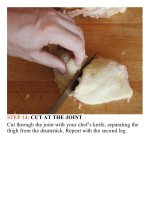The food lab better home cooking through science ( PDFDrive ) 469
Bạn đang xem bản rút gọn của tài liệu. Xem và tải ngay bản đầy đủ của tài liệu tại đây (177.59 KB, 2 trang )
And because the water bath is maintained at the final
serving temperature of the meat, there’s absolutely no way
youcanovercookit.Needtowalkthedog?Noproblem—
yoursteakwillbewaiting.Forgottoaddthefabricsoftener?
Takeyourtime.Thesteakwillstillbethere,exactlyasyou
left it. This makes hosting dinner parties extraordinarily
easy.
Because the Maillard browning reaction doesn’t take
place at standard sous-vide temperatures, most recipes call
forsearingmeatinahotskillettoaddcolorandflavorafter
removingitfromthebag.
In addition, meat naturally contains enzymes called
cathepsins that slowly break down tough muscle tissue at
first and then work faster and faster as the temperature
increases. Giving the meat extra time in the lower
temperature range means the cathepsins work overtime,
making an already tender steak even more tender. And
tender meat is not just about texture—the more loosely
packed the muscle fibers, the less they contract during
cooking and the fewer juices they expel, making the slowcookedmeatmorejuicyaswell.
Theadvantageforrestaurantchefsisobvious.Evenatthe
bestrestaurantsintheworld,whenusingtraditionalcooking
methods, the occasional over- or undercooked protein can
be a problem. The seasoned line cooks at Peter Luger’s,
who’ve been turning-and-burning steaks since before
vegans existed, still produce the occasional slightly-toowell-done porterhouse. But with sous-vide cooking, even a
monkey with a toupee can produce perfectly cooked
proteinswithoutfail:ChickenwithajuicinesstheColonel’s
wifeonlydreamedof.Salmonsotenderitmeltsifyoulook
at it too hard. The kind of double-thick pork chops that
would’vemademebreakoutacelebratoryPBRmidservice
whenIwasstillalinecook.We’retalkingperfectfoodhere.
Of course, there’s a catch, and it’s a big one: a typical
water circulator will set you back about $1,000. Even the
cheaperhomeversionsnowonthemarket(liketheSansaire
andtheAnova)areatleastacouplehundreddollars,allin.
Infact,there’sawholelegionofpeopleoutthereonthe
internet who’ve devoted considerable time and resources
into figuring out ways to put together a cheaper sous-vide
setup.Thesefallintotwocategories:
• Category 1:The rice-cooker, aquarium-bubbler, PIDcontroller method. It’s accurate, but it requires a fair
amount of DIY know-how and costs a couple hundred
dollarstohacktogether.
• Category 2: The David Chang pot-of-water-on-thestove, fiddle-with-the-heat-as-necessary method. This is
less accurate, and it requires you to hover around the
stovefortheentirecookingtime.
Convincedthattherewasafaster,easier,cheaper,andmore
foolproof way to achieve the same results, I started poking
around. Essentially, in order to create a low-temperature
water cooker, all you need to do is keep a large body of
water at the same temperature for a couple of hours: so, a
well-insulated box should do the trick. And, fortunately,
there’s already a tool in pretty much every home that’s
designedpreciselyforthepurposeofkeepinglargevolumes









